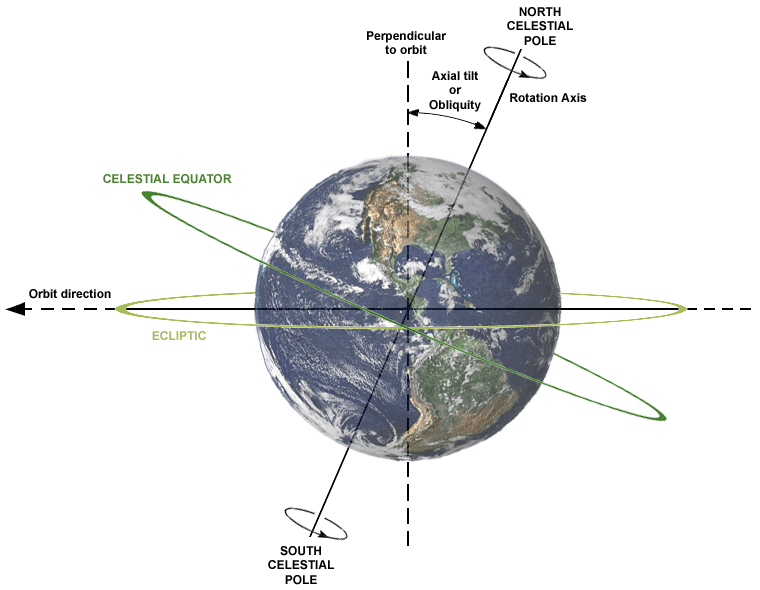Chinese and Indian astronomers were the first to measure Earth’s axial tilt accurately, and they did it about 3,000 years ago. Their measurements were remarkably accurate: in 1120 BC, Chinese astronomers pegged the Earth’s axial tilt at 24 degrees. Now we know that all of the planets in the Solar System, with the exception of Mercury, have some tilt.
While astronomers have puzzled over why our Solar System’s planets are tilted, it turns out it’s rather normal. Now that astronomers have observed so many other solar systems, they’ve learned that axial tilt is to be expected, even in so-called “pristine” solar systems. Pristine refers to the precise mathematical relationship between planets.
New research in The Astronomical Journal explains why some axial tilt is to be expected. It’s titled “ Evidence for Low-level Dynamical Excitation in Near-resonant Exoplanet Systems. ” The lead author is Malena Rice, an assistant professor of astronomy at Yale’s Faculty of Arts and Sciences.
The orbital resonance concept is at the heart of this research. As planets orbit a star, they can exert regular and periodic gravitational influence on one another. When they do, astronomers say they’re in resonance with one another.
It also happens in moon systems around planets with many moons. Some resonant systems can be self-stabilizing, while others can become unstabilized over time. Early in a solar system’s history, planets are more likely to be in resonance with one another.
“This type of configuration, where one planet’s orbit is precisely ordered with another in an exact integer ratio of orbital periods, is likely common to find in a solar system early in its development,” said Rice. “It’s a gorgeous configuration — but only a small percentage of systems retain it. ” “Given that near-resonant systems have likely experienced minimal dynamical disruptions, the spin-orbit orientations of these systems inform the typical outcomes of quiescent planet formation, as well as the primordial stellar obliquity distribution,” the authors write in their research.
The spin-orbit orientation is the tilt of companion planets’ orbits relative to the host star’s spin axis. What that boils down to is that in a system that’s suffered few disruptions, like migrating planets, for example, the spin-orbit and axial tilt of the planets in the system should be largely unchanged from the time of formation. But the problem is astronomers haven’t rigorously measured the spin-orbit orientations of near-resonant systems.
“To date, only a handful of near-resonant systems have had spin-orbit angles measured to characterize the tilts of their constituent planetary orbits,” the authors explain in their research. In this work, the researchers started out by examining a warm Jupiter named TOI-2202 b . It’s a near-resonant planet that’s only slightly less massive than Jupiter.
It orbits a K-type star about 770 light-years away. TOI-2202 b is tight to its star, only 0. 09564 AU away, and it completes an orbit in only 11.
9 days. For comparison, Mercury is 0. 387098 AU away from the Sun.
TOI-2202 b is in a pristine solar system, and it’s in a 2:1 mean-motion resonance with another planet further from the star. The researchers compared it to archival data and new observations of the exoplanet from multiple telescopes. They arrived at a spin-orbit angle of about 31 degrees.
Then they compared that to the full census of other similar planets in pristine systems found in NASA’s Exoplanet Archive . “To place this measurement into context, we examined the full set of transiting exoplanet systems with (1) a sky-projected spin-orbit measurement and (2) evidence that the transiting planet lies near a low-order mean-motion resonance with a neighbouring companion,” the authors explain in their research. They found that planets in these pristine systems exhibit a typical spin-orbit angle of around 20 degrees.
So even “quiet” solar systems have axial tilt. TOI-2202 b was one of the most strongly tilted planets in the sample. “The measured spin-orbit angle of TOI-2202 b, together with the full census of spin-orbit measurements for near-resonant exoplanets, indicates that even quiescently formed systems may experience low-level dynamical excitation that produces some dispersion in their spin-orbit orientations,” the authors write.
This told the researchers that our Solar System’s tilted planets are the norm rather than an oddball outlier. “It’s reassuring,” Rice said. “It tells us that we’re not a super-weird solar system.
This is really like looking at ourselves in a funhouse mirror and seeing how we fit into the bigger picture of the universe. ” Our Solar System does contain one oddball, though: Uranus. Uranus’s tilt angle is 97.
77 degrees, nearly parallel to the Solar System’s plane. Astronomers aren’t certain, but a collision with an Earth-sized protoplanet in the Solar System’s early days is likely the cause. One of Rice’s research areas concerns hot Jupiters and why they exhibit such pronounced axial tilts.
“I’m trying to figure out why systems with hot Jupiters have such extremely tilted orbits,” Rice said. “When did they get tilted? Can they just be born that way? To find that out, I first need to find out what types of systems are not so dramatically tilted. ” That search continues.
.
From: universetoday
URL: https://www.universetoday.com/164520/it-doesnt-take-much-to-get-tilted-planets/



